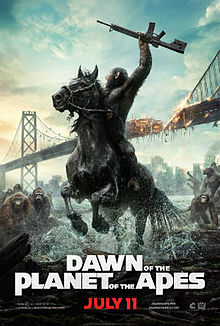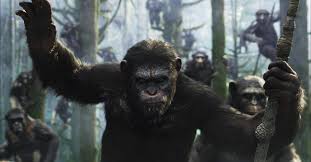|
“Dawn of the Planet of the Apes” stars Andy Serkis, Jason Clarke, Gary Oldman, Keri Russell, Toby Kebbell, and Kodi Smit-McPhee. Released on July 11, 2014, the film has Caesar struggling to keep his community of intelligent apes alive while the humans search for a way to survive the aftermath of a plague. The film is directed by Matt Reeves, who also directed Cloverfield and Let Me In, and it is a sequel to the 2011 film, Rise of the Planet of the Apes. With the success of Rise, multiple sequels were being discussed to continue the story of Caesar and his ape family. Rupert Wyatt, the director of Rise, decided not to return to direct Dawn due to his concerns about the release date and handed over the reigns to Cloverfield director Matt Reeves. Cloverfield and Dawn are the only two movies I’ve seen that Reeves directed and while I did enjoy Cloverfield for its tone and its entertaining found-footage style, it was actually Dawn that got me captivated with Reeves’ storytelling. I only saw this film twice in the theater and I can not tell you how much this film affected me on the inside. In fact, I actually liked it a lot more than Rise of the Planet of the Apes, which usually doesn’t happen a lot with sequels. Keep in mind that it’s about a group of CGI apes. Looking back at it now as a critic, I still happened to love every minute of it. The story takes place ten years after the events of Rise, with the ALZ-113 virus wiping most of the human population off the face of the planet. The remaining survivors who are immune to the virus built their own safety zone in San Francisco to protect themselves. Meanwhile, Caesar (played by Serkis) and the apes built their own civilization in the woods near the city so they can live their own lives without any humans hunting them. Unlike its predecessor, this sequel tends to be a lot darker in terms of its tone and the stakes that these characters are facing. It’s violent in some occasions, but that doesn’t mean it lacks the emotional depth and the message that it’s getting across. That’s one of the reasons why this sequel is a big hit for me. They provided the action spectacle to showcase the consequences of violence, not just for the sake of entertaining its audience. Matt Reeves was a great choice to direct this film because of his ability to develop not just the human characters, but also the apes. When I finished watching this film, I realized that, in my own assumption, these characters, both human and ape, are not described as heroes or villains. They are described as beings who are driven by their own emotions to make the choices that either help or hurt themselves and those around them. Koba (Toby Kebbell), Caesar’s lieutenant, is a good example because his anger towards the humans for experiment mistreatment lead him towards a darker path (no spoilers in case you haven’t seen it yet). The way they executed this type of development was something that other directors should take note of if they’re planning on making something like this. This is one of those things that really affected the way I see summer blockbusters. The entire cast delivered some great performances from start to finish. Jason Clarke was pretty impressive as Malcolm, one of the humans who befriended Caesar, and Gary Oldman delivered an affective performance as Dreyfus, the leader of the remaining human survivors who wanted the one thing that the apes also want: survival. Andy Serkis takes center stage as he once again provided the voice and motion capture for Caesar, and he stole the entire show like he did in Rise of the Planet of the Apes. I still love the way they developed Caesar for this film because of the responsibilities he had as the leader of the apes. He knows what the humans did to the apes, but he refuses to wage war on them because if that happens, then he and his community will suffer unimaginable losses and their chance at living in peace will die with them. I can tell you one thing, no one can make this character feel more real than Serkis himself. The visual effects also made an upgrade compared to its predecessor. In my review for Rise, I said that the visuals were impressive, but looking back at it six years after its release, there were some occasions where the CGI on the apes looked dated. Here, however, the visuals still looked amazing after watching it again now. Everything about the visuals, including the apes, made the experience much more thrilling and realistic than any other sci-fi blockbuster. The musical score by Michael Giacchino was also very clever in showcasing the emotion from certain scenes without being forceful. Overall, “Dawn of the Planet of the Apes” is not only one of my favorite sequels in years, but also one of the most stunning and well-developed summer blockbusters that anyone has ever made. The film managed to kick it up a notch with its tone and the action without losing sight of the character development and the emotion that it’s going for. The performances were great, Andy Serkis was brilliant as Caesar, and Reeves’ storytelling was nothing but pure genius. Now that I’m caught up with the first two films of the reboot series, I think it’s safe to say that I’m ready to fight in the war. Not the actual war, the war for the planet of the apes. Why would I want to fight in a real war? That’s just messed up. If you like Rise of the Planet of the Apes and are familiar with the 1968 version of Planet of the Apes, I can assure you that you won’t be disappointed with this. Apes…together…strong. A
0 Comments
Leave a Reply. |
Home of the most friendly movie reviews on the planet.
Categories
All
Follow Me |
- Home
- Classic Reviews
- 2015 Reviews
- 2016 Reviews
- 2017 Reviews
- 2018 Reviews
- 2019 Reviews
- 2020 Reviews
- 2021 Reviews
- 2022 Reviews
- 2023 Reviews
- 2024 Reviews
- Movie Talk
-
Fan Fictions
-
Ed, Edd n Eddy: The Ultimate Ed-Chronicles
>
-
The 'Beginnings' Saga
>
- Ed, Edd n Eddy: The Rise of Maleficent >
- Transformers: Legend of the Black Cauldron >
- Ed, Edd n Eddy meets the Penguins of Madagascar >
- The Eds and Iron Man: Dawn of the Blowhole >
- Ed, Edd n Eddy: The Fast and the Furious >
- The Eds and Kung Fu Panda: Battle for China >
- Ed, Edd n Eddy and the Lion King: The Full Circle >
- Ed, Edd n Eddy meets Thumbelina: Revenge of the Shredder >
- Ed, Edd n Eddy: Journey to Neverland >
- Ed, Edd n Eddy: All Tangled Up >
- Ed, Edd n Eddy's Frozen Adventure >
- Ed, Edd n Eddy's Edventures in San Fransokyo
- Ed, Edd n Eddy: Return to Neverland
- Ed, Edd n Eddy vs The League of Evil
-
The 'Avengers' Saga
>
- The Eds and the Little Mermaid: Age of Extinction
- Ed, Edd n Eddy meets the Ghostbusters
- Ed, Edd n Eddy: A Sea of Adventure
- Ed, Edd n Eddy meets Anastasia
- Ed, Edd n Eddy in Who Framed Roger Rabbit?
- Ed, Edd n Eddy meets the Incredibles
- Ed, Edd n Eddy and the Lion King 2: Simba's Pride
- Ed, Edd n Eddy: Brand New Zootopia
- Ed, Edd n Eddy: Into the Sugar Rush
- Ed, Edd n Eddy and the Big Sea Quest
- Ed, Edd n Eddy: Heroes Assemble
- Fastformers: Rio Heist
- The Loud Ghostbusters >
-
The 'Beginnings' Saga
>
-
Ed, Edd n Eddy: The Ultimate Ed-Chronicles
>
- Contact
- About


